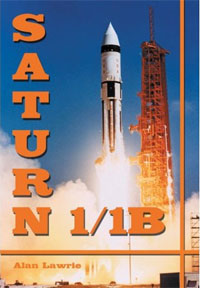|
|
Review: Saturn I/IB
by Jeff Foust
Monday, November 24, 2008
Saturn I/IB
by Alan Lawrie
Apogee Books, 2008
softcover, 192 pp., illus.
ISBN 978-1-894959-85-8
US$26.95
In the history of spaceflight no rocket is arguably as revered as the Saturn 5. It has been virtually canonized—St. Saturn the Fifth, if you will—having performed the miracle of sending humans beyond Earth orbit and on to the Moon just over a decade after the Space Age began. The remaining Saturns have all since been rescued from rust and exposure to the elements, restored and placed in grand new homes (shrines?) so that people can experience them in all their glory. The Saturn 5 has also been the subject of many books and documentaries about its development and its historic role in space exploration.
And then there is the humble Saturn 1. The vehicle shared some technology and components, including an entire stage (the S-IVB), with the Saturn 5, but was lost in the shadow of its bigger sibling. The vehicle launched the first crewed Apollo mission, Apollo 7, and later launched the crews for the three Skylab missions and the final Apollo mission, Apollo-Soyuz. But the rocket has gotten only a fraction of the attention of the Saturn 5: rather than being restored and placed in new homes, one Saturn 1 stands sentry at an interstate rest stop in Alabama. Engineer and historian Alan Lawrie tries to give the rocket the attention it’s due in Saturn I/IB.
| The rocket has gotten only a fraction of the attention of the Saturn 5: rather than being restored and placed in new homes, one Saturn 1 stands sentry at an interstate rest stop in Alabama. |
Those expecting a narrative history of the Saturn 1 in this book will be disappointed. Instead, Saturn I/IB includes a detailed technical record of the development and production of the rocket (the book’s subtitle, not included on the cover but listed on the title page inside, is “The Complete Manufacturing and Test Records”). The book lives up to that description, describing the development and ultimate disposition of every stage and even every rocket engine that was part of the Saturn 1 and 1B. Lawrie also discusses the various factories and test sites used in the vehicle’s development, and even the aircraft and barges that transported components. A companion DVD includes several NASA film updates from the early development of the Saturn 1 as well as a PDF with detailed schematics of the Saturn 1.
Given this focus, the book doesn’t put the development and use of the Saturn 1 into a greater historical context: why it was developed, why it wasn’t used more, and so on. Saturn I/IB is instead more of a technical reference book, a tool for those looking for the nitty-gritty details behind each Saturn 1 built. This book may not be the complete history of this launch vehicle, but its publication is a little greater sign of respect for an oft-overlooked rocket.
Jeff Foust (jeff@thespacereview.com) is the editor and publisher of The Space Review. He also operates the Spacetoday.net web site and the Space Politics and Personal Spaceflight weblogs. Views and opinions expressed in this article are those of the author alone, and do not represent the official positions of any organization or company, including the Futron Corporation, the author’s employer.
|
|
